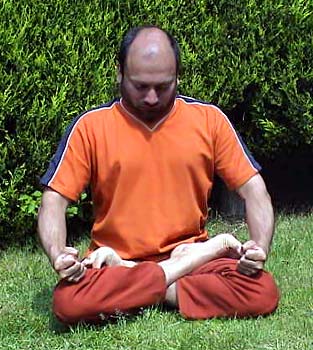Quite a handful of Yogic pupils practice Jalandhara-Bandha or The Chin Lock, mainly to prevent aging. It contracts the throat and then fixes the chin tightly above the chest. Some even held it in high esteem as, according to many, it has the quality of prolonging one`s life thus overpowering heinous death. The name has interesting derivations. In ancient literature of Indian Yogists, the word Bandha means a tie and is applicable for various muscular contractions and loosening, which create an impact on all the vascular nervous systems and glands.
Even, some have pointed out few other advantages of doing Jalandhara-Bandha or The Chin Lock. This exercise influences the functioning of all the important arteries, which supply blood to the human brain. It also brings about some physiological effects on a specific nerve of the nervous system. In fact, this Pranayamic exercise is called Jalandhar as it pushes on the arteries going to the brain and also checks the downward flow of `nectar` emerging from it.
 Jalandhara-Bandha or The Chin Lock makes use of a special technique. As has been already said, due to this the throat gets condensed, which means that blockage has been created on the two vocal cords, which are located in the larynx. Measures need to be taken further to close these cords for holding the breath. Glottis marks the opening space in between the two cords and with its closure , one needs to constrain the neck muscles. A tough task follows afterwards. One curves his head to its utmost extent and then pushes his chin on the chest as tightly as possible.
Jalandhara-Bandha or The Chin Lock makes use of a special technique. As has been already said, due to this the throat gets condensed, which means that blockage has been created on the two vocal cords, which are located in the larynx. Measures need to be taken further to close these cords for holding the breath. Glottis marks the opening space in between the two cords and with its closure , one needs to constrain the neck muscles. A tough task follows afterwards. One curves his head to its utmost extent and then pushes his chin on the chest as tightly as possible.
During respiration, these techniques of Jalandhara-Bandha or The Chin Lock may be adept at any stage. However, sometimes it is to be applied after deep inhalation, while in other cases the vocal cords need to be more or less relaxed.
Anatomy and Physiology of Jalandhara-Bandha or The Chin Lock can be an interesting for a thorough study. However, still experiments are going on an exuberant way over all these years, which would increase the physiological and also psycho- physiological aspects of the exercise. It would also provide the scientific grounding to this beautiful pranayamic asana.
Before going into the details it becomes imperative for a reader to know something of the
anatomical structuring of any human body. Three anatomical structures are namely, the internal and external carotid arteries, the carotid sinus, and also the sinus nerve.
The internal and external carotid arteries are located in the neck. They form the branches of the `common carotid`. These two arteries are chiefly responsible for supplying blood to the human brain. They are to be found on both the sides of the neck.
The carotid sinus is an expanded aperture present at the branching of the familiar carotid artery .It is usually constrained to the first portion of the internal carotid. The walls of this sinus are so thin, that they succumb without difficulty to the pressure applied to it both internally and externally.
The sinus nerve, on the other hand, is an offshoot of a `cranial nerve` appearing from the human brain. It rises just below the skull and then it comes down on the internal `carotid artery`. From there it gets circulated to the wall of the `carotid sinus`. The sinus nerve is falls into the category of a special type of nerve, which gets energized both by pressures from inside as well as from outside. In the case of the sinus nerve, one can generate the external pressure by pressing the carotid sinus with the use of one`s own thumb and the forefinger also.
After discussing certain aspects of the anatomical features of Jalandhara-Bandha or The Chin Lock, it is important to throw some light on the physiological values of it. Any Yogist should press with his two fingers the two carotid nerves, present on both the sides of the neck. One who perfects this exercise; it is said one feels celestial feeling.
Steps for Practice Jalandhara Bandha:
1. Sit in Padmasana or in any comfortable meditative posture.
2. Bend your neck a little forward.
3. Slowly place firmly your chin on chest (jugula knotch) so that when you practise Pranayama with Kumbhaka, the inside retained air must not come out.
4. While returning, slowiy raise your chin and straighten your neck.
Benefits of Jalandhara Bandha
This Bandha influences our vocal organs directly.
Precautions
1. Those having complaint of pain in neck or spondilitis should not practise it.
2. The bandha is not to be practiced by persons suffering from breath related problems or high or low blood pressure, unless under supervision by the experts in the field.
3. During Pranayama, the bandha is to be observed after Pooraka. Rechaka is to be practiced after Kumbhaka, after releasing the bandha. Rechaka should not be observed while being in the Jalandhara bandha.
Beginner`s Tip: Beginner`s are advised to practise this Bandha for a few seconds only initially.



